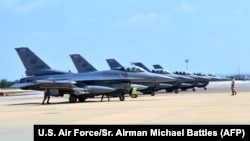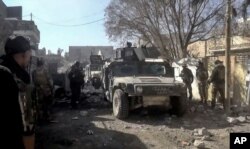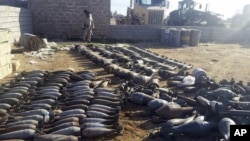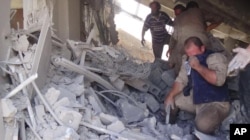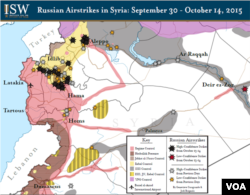Washington’s reluctance to risk civilian casualties in the U.S.-led air campaign against the Islamic State terror group is again being questioned as Iraqi forces, with the support of American air power, try to wrest control of the Iraqi city of Ramadi from IS.
After weeks of fighting on Ramadi’s outskirts, Iraqi security forces crossed the Euphrates River on Tuesday and moved on the city center, trying to oust an estimated 250-300 Islamic State fighters.
The area is said to be “tightly packed,” with many of the buildings and narrow streets most likely wired with booby traps and other improvised explosive devices.
Held as human shields
The prospect of thousands of civilians, perhaps even tens of thousands, either trapped or being held as human shields means airstrikes could be few and far between.
“We won't strike if we think a strike is going to cause significant civilian harm,” Operation Inherent Resolve spokesman Colonel Steve Warren told Pentagon reporters from Baghdad this week.
Critics of the current U.S. rules of engagement, while not insensitive to civilian deaths, argue that type of policy is shortsighted.
“If you don’t want to clear out buildings using bombs and destroy them that way, you’re going to have to do it on the ground. And guess what? Civilians are going to be killed with gunfire and in artillery attacks,” said Bill Roggio of the Foundation for Defense of Democracies, a research and education group in Washington. “You’re probably going to have a greater loss of Iraqi troops as well.
“What I think you have is the U.S. military and political leaders that are overly concerned about the optics more than the objective," Roggio said.
'Sectarian butchery'
Others add that there are additional consequences of the reluctance to allow for civilian casualties from the use of U.S. air power.
“Air forces are being shackled with unwarranted constraints, leaving civilian populations to suffer sectarian butchery by the IS,” said retired Lieutenant General David Deptula, who helped lead previous air campaigns over Iraq and Afghanistan.
“The U.S. operates under a zero-civilian-casualty standard that far exceeds the standards of international law,” he said. “It yields the Islamic State the equivalent of an air defense capability they do not have to pay for, equip or man to employ.”
Still, U.S.-led airstrikes have caused some civilian casualties.
Airwars.org, a London-based not-for-profit transparency project, estimates that 783 to 1,109 civilian noncombatants most likely have been killed in coalition airstrikes since the start of the campaign in August 2014.
Of those, up to 550 were killed in strikes in Syria.
In contrast, Airwars.org estimates the first 32 days of Russia’s air campaign in Syria killed from 345 to 501 civilians.
War crimes?
A report this week by the human rights group Amnesty International said Russia’s disregard for civilian casualties in its efforts to support the regime of Syrian President Bashar al-Assad may amount to war crimes.
“Residential areas were directly hit because there seem to be absolutely no military targets in the vicinity,” Anna Neistat, Amnesty's senior director for research, told VOA, speaking of the documented incidents.
“In one case, the attack appears to be disproportionate even though there might have been a mystery target in the vicinity,” Neistat said.
Yet while condemning Russia’s use of so-called “dumb bombs” and its disregard for civilian losses, some analysts point out the Russian air campaign is helping achieve at least some of Moscow’s objectives.
A report by the Institute for the Study of War, a nonpartisan think tank in Washington, criticized Moscow’s disregard for international norms, yet concluded Russian airstrikes between December 18 and December 21 did enable pro-regime Syrian forces to “seize the key town of Khan Touman and several nearby villages.”
Less restriction
Critics of the U.S. rules of engagement say that while they are not advocating the same type of disregard for civilian casualties attributed to Russia, a loosening of the current restrictions is needed.
“While unintended casualties of war must be avoided to the extent possible, those associated with airstrikes pale in comparison to the savage acts of the Islamic State,” Deptula said.
For now, despite acknowledging that the campaign against Islamic State must be intensified, U.S. officials have remained reluctant to loosen the guidelines.
“We are going to take every bit of precaution that we can to ensure that we don't create civilian casualties,” Warren told Pentagon reporters this month.
“This has been the most precise air campaign, I think, in the history of air campaigns, in the history of warfare, frankly,” he said. “Never has such precision been brought to bear in a situation like this.”




